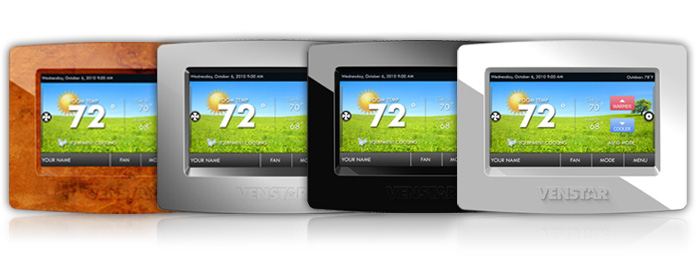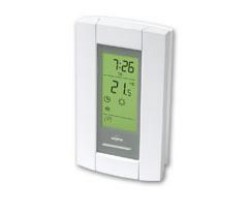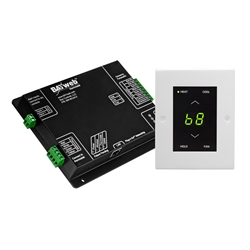Are you confused about the multitude of programmable thermostats on the market today? Well, it’s no wonder – the big box hardware stores carry more than 40 different models! A basic programmable thermostat typically has 7-day programming, but now there are programmable thermostats called “smart†and others called “learning.† Is there a difference? And what about a remote thermostat vs. a WiFi thermostat?  How do they compare?
This article – Part 1 in a series — provides an overview of the different types of programmable thermostats. Parts 2 and 3 will talk about programmable thermostats for the home and how to choose one that fits your HVAC equipment and lifestyle. Part 4 will discuss programmable thermostats for commercial or public work places, which have some unique requirements that residential applications may not have.
First, let’s look at what makes a thermostat “programmable:â€
Non-Programmable vs. Programmable Thermostats
Non-programmable thermostats allow users to manually adjust heating and/or cooling systems to one temperature setting. You may be familiar with the traditional round, dial-style thermostat used to adjust the heat in your home. If you want to control both your heating and air conditioning systems with one thermostat, you’ll need a digital model. Non-programmable thermostats are easy-to-use and inexpensive, but they’re not very energy-efficient or convenient (unless you’re hanging around the house all of the time to make adjustments!).
Programmable thermostats are popular because they make it easier for users to maximize comfort while saving on energy. With a programmable thermostat, you can regulate temperature based on your own day and nighttime schedule. Most programmable thermostats offer 7-day programming and up to 4 program periods a day, so you can program the thermostat to automatically adjust temperature for the times when you are at home, asleep or away, so you don’t waste energy heating or cooling an empty house.  All are digital and most can be used for both heating and A/C.
Remote vs. WiFi Thermostats
 Remote thermostats allow you to adjust the temperature in your home or office from anywhere via a landline phone or from your computer or smartphone through a high-speed Internet connection, depending upon the model. Remote thermostats are very popular with vacation homeowners who want to pre-heat or cool their home before they arrive. They are also great for anyone who wants to adjust the temperature when they are out or to deviate from the programmed schedule.
Remote thermostats allow you to adjust the temperature in your home or office from anywhere via a landline phone or from your computer or smartphone through a high-speed Internet connection, depending upon the model. Remote thermostats are very popular with vacation homeowners who want to pre-heat or cool their home before they arrive. They are also great for anyone who wants to adjust the temperature when they are out or to deviate from the programmed schedule.
WiFi thermostats are a type of remote thermostat that allows users to control temperature settings remotely through a wireless Internet connection. Unlike an Internet thermostat that uses a cable to connect to a router, a WiFi thermostat is equipped with a WiFi module that communicates with your router wirelessly.
For more information on the different types of remote thermostats, read the article “How to Choose Between an Internet Thermostat, WiFi Thermostat & Phone Thermostat.â€Â
Smart vs. Learning Thermostats
Smart thermostats are basically high-tech programmable thermostats with extra bells and whistles to increase energy savings and user-friendliness. Features of a smart thermostat typically include:
- Temperature control from your smartphone or computer (many come with special smartphone apps);
- Web portal for viewing your HVAC system’s runtime and energy consumption;
- Access to current weather and weather forecasts;
- Ability to send alerts to your smartphone or computer if there’s a problem with your HVAC system.
Learning thermostats are smart thermostats with a built-in occupancy sensor that allows it to “learn†your daily habits so it can create a customized temperature schedule based on your activity. Learning thermostats also measure things such as ambient light, humidity, and motion and use that information to fine-tune its program. If it detects that you’re not home on the weekend when you usually are, it adjusts accordingly, even if the standard program dictates otherwise. The upshot is you don’t have to program a learning thermostat yourself, which some people find appealing.
Summary
Regardless of how your home is heated or cooled, the energy you use is undoubtedly a big part of your household or office budget, and a programmable thermostat can help keep costs down. Parts 2, 3 and 4 of this series will help you choose a programmable thermostat for your home or business based on some very important criteria, including your situation, HVAC equipment and your habits.





Pingback: Choose a Programmable Thermostat Compatible with your Lifestyle
Stephen Inch
Thank you for this informative article. This is an excellent overview of the issues in choosing the right smart thermostat for your home or business. I am particularly interested in hearing more about the cost savings that folks are achieving with these devices.